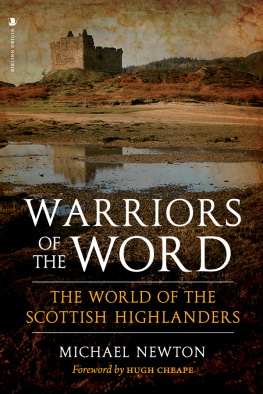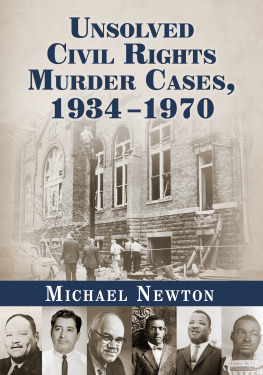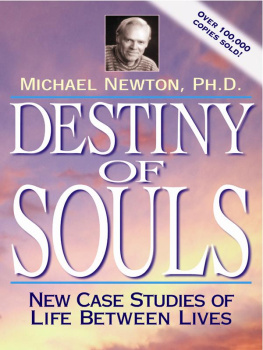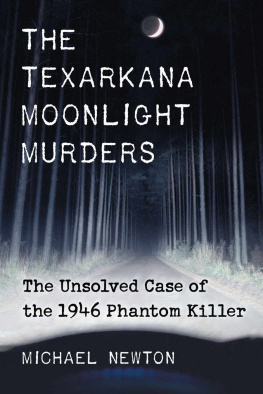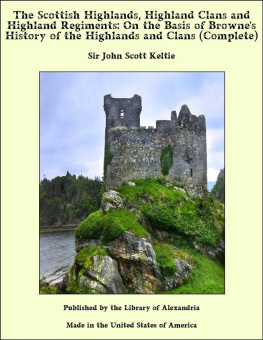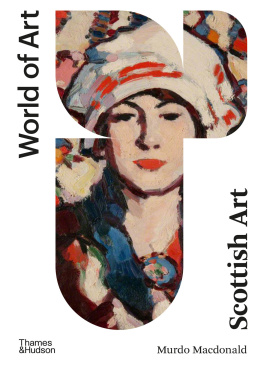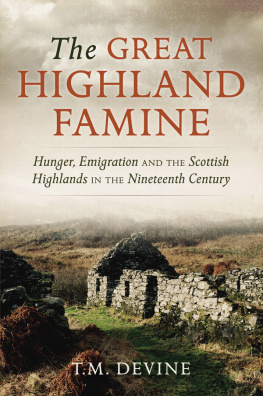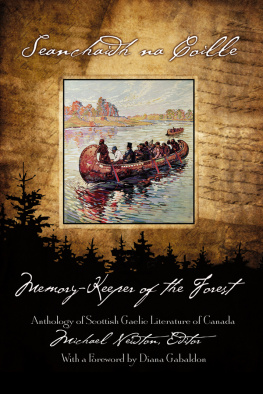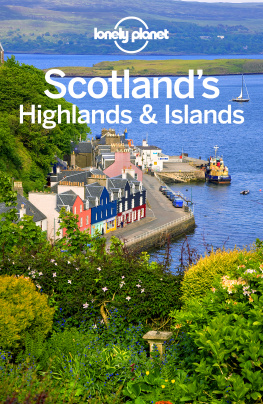Contents
Guide
Dr Michael Newton earned a PhD in Celtic Studies from the University of Edinburgh in 1998 and was an Assistant Professor in the Celtic Studies department of St Francis Xavier University in Nova Scotia, 20082013. He is the editor of Dthchas nan Gaidheal: Selected Essays of John MacInnes, which won the Saltire Societys Research Book award of 2006, and the author of Warriors of the Word: The World of the Scottish Highlanders, which was nominated for the 2009 Katharine Briggs Award for folklore research. In 2014 he was given the inaugural Saltire Award by the St Andrews University Scottish Heritage Center (of Laurinburg, North Carolina) for his outstanding contributions to the preservation and interpretation of Scottish history and culture. In 2018, he was recognised with the International award at the annual Scottish Gaelic awards in Glasgow, Scotland.
WARRIORS
OF THE WORD
The World of the Scottish Highlanders
Michael Newton

This edition first published in 2019 by
Birlinn Origin, an imprint of
Birlinn Limited
West Newington House
10 Newington Road
Edinburgh
EH9 1QS
www.birlinn.co.uk
First published by Birlinn Ltd in 2009
Copyright Michael Newton 2009, 2019
The moral right of Michael Newton to be identified as the author of this work has been asserted by him in accordance with the Copyright, Designs and Patents Act 1988
All rights reserved.
No part of this publication may be reproduced, stored or transmitted in any form without the express written permission of the publisher
ISBN: 978 0 857907 67 7
British Library Cataloguing-in-Publication Data
A catalogue record for this book is available from the British Library
Typeset by Geethik, India
Printed and bound by Clays Ltd, Elcograf, S.p.A.
CONTENTS
LIST OF ILLUSTRATIONS
Pictish carnyx, c. AD 100, found in Deskford, Banffshire.
Hunterston Brooch, c. AD 700.
Brecbennach, the eighth-century portable shrine known in English as the Monymusk reliquary.
Kildalton Cross, Islay.
The figure of a warrior wearing short breeks in the Book of Kells.
An early Christian carved stone with ogham inscribed on its side from Bressay, Shetland.
Chapel dedicated to St Odhran, Iona.
A nineteenth-century depiction of a fourteenth-century engraved graveslab from Iona for Giolla Brighde MacKinnon.
Gravestone found in ruined chapel at Finlaggan, Islay, with inscription to Domhnall Mac Giolla Easpaig, probably from the mid sixteenth century.
A graveslab in Keills, Knapdale, probably from the late fifteenth century.
The finest surviving early clrsach, referred to as Queen Marys Harp.
A page from the Book of the Dean of Lismore.
A baptismal font from Borline, Skye, with an inscription date 1530 naming the probable patron, Iain MacLeod.
A crannog in Loch Freuchie near Amulree in Perthshire, at which local tradition sets Laoidh Fhraoich (The Lay of Fraoch).
The drinking horn used in the inaugural ceremony of the MacLeods of Dunvegan.
A nineteenth-century reproduction of the family tree of the Campbells of Glenorchy as drawn in 1635 by George Jamesone
An engraved silver brooch owned by a member of the MacNabs who emigrated to Canada.
An illustration of Highlanders at the market in Inverness, from Letters from a Gentleman in the North of Scotland by Edmund Burt (1754).
A reconstructed thatched house in the Kingussie Folk Museum in Badenoch.
An illustration of the inside of a weavers cottage in Islay, from A Tour in Scotland and Voyage to the Hebrides in 1772 by Thomas Pennant.
Two women work a quern (grinding corn) while a group of women sing a waulking (or fulling) song as they pound the tweed with their feet, from Pennant (1774).
Two women working the quern to grain their corn.
The sporran once belonging to Rob Roy MacGregor.
The title page of the first anthology of Gaelic poetry, usually called the Eigg Collection, published in 1776 by Raghnall Dubh MacDonald.
The title page of the first collection of Gaelic proverbs, published by Donald Macintosh in 1785.
An illustration from the title page of Airs and Melodies Peculiar to the Highlands of Scotland and the Isles by Captain Simon Fraser (1816).
Portrait of the pioneer folklorist John Francis Campbell of Islay, known in Gaelic as Iain g le.
ACKNOWLEDGMENTS
I have been fortunate to have received the encouragement and support of many friends and colleagues over the years in which I have been collecting and researching Scottish Gaelic matters, too many to name here. It is my hope that this work honours the generosity I have received from innumerable people who have offered me help, hospitality, and encouragement in the conviction that it would be for the greater good.
This volume draws in a number of places on the research I carried out in the course of my doctoral degree in the Celtic department of the University of Edinburgh. I received formal supervision and instruction during my training from Ronald Black, Thomas Owen Clancy, William Gillies, Allan MacDonald, and Roibeard Maolalaigh, as well as informal guidance and inspiration from Margaret Bennett and John MacInnes. To them all I owe an immeasurable debt of thanks. I would also like to thank the Clan Donald Educational and Charitable Trust, the Overseas Research Scholarship, and the Richard Brown Scholarship, whose contributions supported my training.
I also owe thanks to a host of readers who provided comments, corrections, suggestions and information of all sorts on this manuscript, including Hugh Cheape, Rodger Cunningham, John Gibson, Peter Gilmore, Tad Hargrave, Russell Johnston, Allan MacDonald, John MacInnes, Alastair McIntosh, Sharon Paice-MacLeod, Robin Edward Poulton, Barry Shears, and Christopher Thompson. I particularly appreciate the substantial contributions and assistance offered by Iain MacKinnon of Sleat (Iain Dhomhnaill Dhomhnaill Dhomhnaill Nill Dhomhnaill Iain), Wilson McLeod, and Keith Sanger. Thanks to Susan Johnston for the enormous task of proof-reading the manuscript. Any and all shortcomings are of course my own.
I must acknowledge and thank the libraries whose resources I used in collecting the material which appears in this volume, including the Celtic Collection of the Angus L. Macdonald Library of Saint Francis Xavier University, the National Library of Scotland, Edinburgh University Library, the libraries of the Celtic department and School of Scottish Studies at Edinburgh University, Glasgow University Library, the library of the Celtic department of Glasgow University, Widener Library at Harvard University, the Edinburgh City Library, and the library of Sabhal Mr Ostaig.
Thanks to the Breadalbane Folklore Centre for permission to print photographs of artefacts in their holdings, to the School of Scottish Studies (University of Edinburgh) for permission to reprint the song Sann a bhruadar mi raoir, to Elaine Dunn for permission to reprint the Christening Song collected by the late Charles Dunn, and to the Scottish Gaelic Texts Society for permission to reprint William J. Watsons Gaelic edition of the poem Roghacht ghaisgidh oighreacht Ein (poem one of Appendix A).
Thanks also to Andrew Simmons of Birlinn for many vital services necessary for the creation of this volume, not least of which was providing me with several highly useful Birlinn books.

